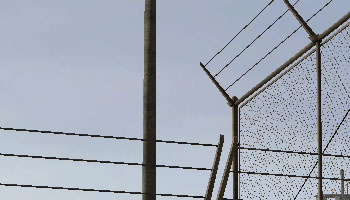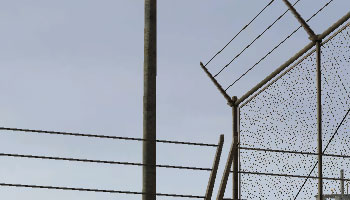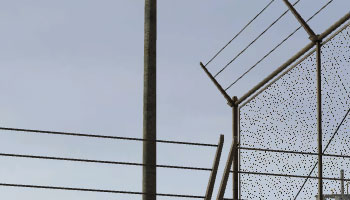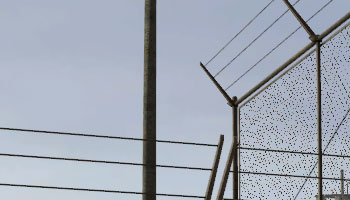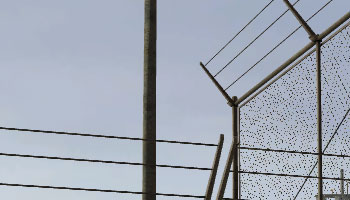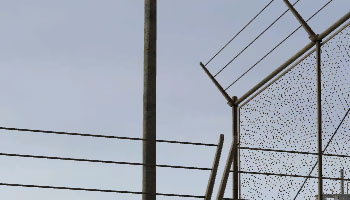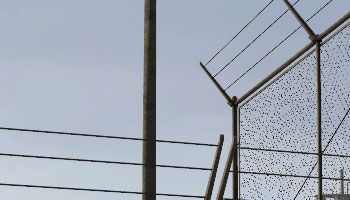Super Anti-aliasing - Sample Grid and IQ Analysis
As mentioned before, Super AA combines multisampling (depth) and supersampling (colour) information from the two graphics boards in Crossfire mode to double sample density and EER (edge equivalent resolution) compared to what a single board is capable of. Ever since R300, ATI desktop graphics processors have had a 12x12 subpixel grid that determines where inside the pixel the hardware samples. With 144 possible sampling locations, getting a good EER is very easy with 6 samples (the maximum possible by one GPU, per pixel) and just as doable with 12 (two GPUs combined).Let's go through all the regular and Super AA modes and I'll explain what EER is along the way. Colourless's D3D AA Tester provides the sample grid confirmation and Half Life 2 (one of the coast levels) provides the in-game screenshot.
0x AA (single board, Crossfire off)

EER:1x1
No multisampling or supersampling provides no increase in image quality, a derth of aliasing on geometry and no improvement for texture aliasing. Even at 1600x1200 it looks bad.
2x AA (single board, Crossfire off)

EER:2x2
EER, or edge equivalent resolution, when talking about AA sample grids is a means to describe the effectiveness of subpixel sampling in improving image quality. The number is presented in the form A x B, where A represents the number of unique samples on the horizontal and B the number of unique samples on the vertical, assuming the subpixel grid is presented as a regular grid. More unique samples in either direction improves the antialiasing that occurs for different shaped geometry that falls inside the pixel. Higher is always better. In a 12x12 subpixel grid, 12x12 is the maximum EER.
In this 2x case, EER is 2x2 which improves on the EER for 0x AA twofold in both planes giving you the increased geometry AA you can see on the chainlink fence's wires, in the cropped screengrab. You can confirm EER for yourself if you look at the sample grid, where red squares on the left are geometry (depth) samples for that pixel. The green squares represent where inside the pixel a colour sample is taken and in this case there's only one, indicating no supersampling and therefore texture antialiasing.
4x AA (single board, Crossfire off)

EER:4x4
EER doubles for both planes again due to the rotated grid used to place the pixel subsamples giving the optimal spacing for four samples. EER is therefore as high as it can possibly be and no supersampling takes place for textures.
6x AA (single board, Crossfire off)

EER:6x6
EER increases again to the best possible given six samples from the 144-position grid. No supersampling happens but geometry antialiasing quality is excellent and still the best seen in consumer 3D hardware to date. 6x AA is the highest image quality a single board can obtain. Super AA modes require a second GPU to calculate ever more separate pixel subsamples for both depth and colour.
8x Super AA (two boards, Crossfire on)

EER:8x8
Still no supersampling with 8xAA, but each board is only calculating 4 samples. Combined, EER is the maximum for the sample count. Image quality, at least from the Half-Life 2 screengrab, appears slightly worse than single board 6x AA though.
10x Super AA (two boards, Crossfire on)

EER:8x8 (2x2 for SS)
10x Super AA uses the same multisample positions as 8x Super AA, but with 2 supersamples thrown into the mix. Looking at the difference you can see the effect on image quality is most noticeable in areas that use alpha textures for transparency in our Half-Life 2 IQ example. Taking more subpixel samples for alpha (which is a 'colour' value in itself and hence affected by supersampling) can improve dramatically the quality of alpha textures in games and applications.
12x Super AA (two boards, Crossfire on)

EER:12x12
12x Super AA offers by far the greatest EER (and therefore overall IQ) for multisampling which affects the appearance of geometry. No supersampling happens in 12x mode and image quality is improved compared to 8x and 10x which both have 8x8 EER.
14x Super AA (two boards, Crossfire on)

EER:12x12 (2x2 for SS)
14x Super AA is 12x Super AA with 2x supersampling. Again, the difference is most visible in our test scenario when dealing with alpha textures.






